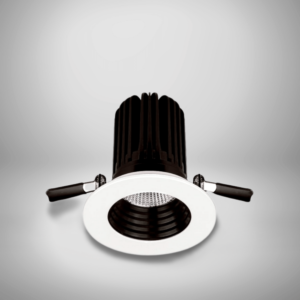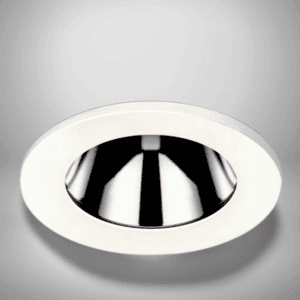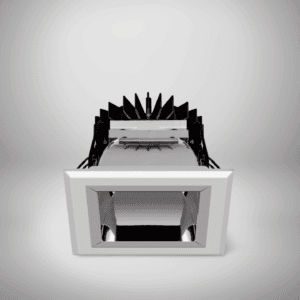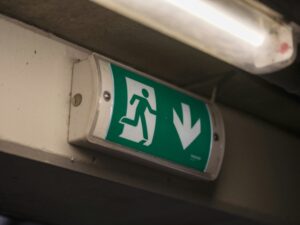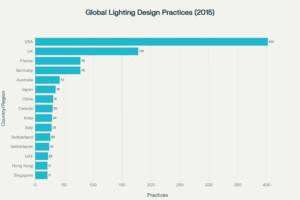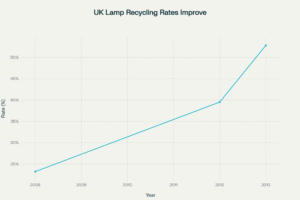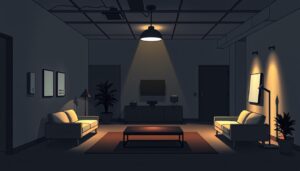Surprising fact: nearly 30% of lighting delays on commercial builds stem from unspecified or non‑compliant fittings, adding weeks to programmes and costs to budgets.
We are Lumenloop, a UK manufacturer of high‑performance luminaires. We write with practical advice that saves time on site and helps meet performance targets.
Choosing a UK-made downlight gives specifiers predictable outcomes on programme, cost and compliance. Local manufacture means tighter quality control and full material traceability aligned to British standards.
We explain how testing, clear documentation packs and short lead times simplify approvals for consultants and MEP teams.
Our aim is to close the loop: supporting repairability, interchangeability and clear end‑of‑life routes so each product and led downlights deliver lasting value rather than waste.
Lumenloop’s perspective: designing high‑performance downlights for UK projects
From concept to commissioning, we tailor light for buildings and teams. We work with UK specifiers to turn brief intent into reliable products that hit programme and compliance targets.
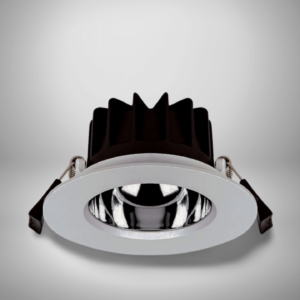
Built for British buildings: compliance, climate and client expectations
We design lighting for UK ceiling types, insulation practices and common compliance routes. That reduces surprises at coordination and handover.
From brief to build: how our product development aligns with spec intent
- Start with target illuminance, UGR, emergency needs and controls strategy.
- Validate thermal and mains stability in typical UK environments.
- Use field‑serviceable components to aid maintenance teams.
- Provide photometry, TM‑30/CRI and driver data for smooth approvals.
- Prioritise reliable dimming and controls to cut commissioning time.
| Stage | Action | Benefit |
|---|---|---|
| Briefing | Confirm illuminance, UGR, emergency | Meets spec intent |
| Testing | UK thermal & voltage validation | Proven performance |
| Delivery | Local spares & firmware support | Faster aftercare |
Practical advice: engage early with us to avoid redesigns and keep the project on schedule.
Why choose a UK-made downlight
Local manufacturing lets us control quality, lead times and aftercare from one site.
Consistent quality control and material traceability
We run 100% functional testing and batch photometry so each fitting matches the specified performance. That means uniform light quality and colour across a whole project.
Material traceability links every product to its suppliers and recyclate streams, helping facilities teams with compliance and ESG evidence.
Faster lead times, reliable aftercare and spares
UK stock and assembly shorten lead times and reduce import delays. We can even preconfigure drivers and connectors to speed first fix and cut installation risk.
Local aftercare keeps projects moving: spare reflectors, drivers and bezels are dispatched quickly to limit downtime.
Lower embodied carbon through local manufacturing
Regional production reduces transport emissions and supports take‑back and refurbishment programmes. We document embodied carbon to help BREEAM and LETI metrics.
- Range of optics and finishes for British ceilings and interiors
- Product engineering tuned for shallow voids and thermal stability
- Early engagement to set beam angle, output and controls to real room data
Standards that matter now: safety, performance and compliance
We package safety and performance data so consultants can approve fixtures fast. Clear, concise packs reduce queries at tender and on site.
BS/EN, UKCA and fire-rated ceilings
We evidence BS/EN and UKCA compliance for safety, EMC and photometric performance. Fire-rated ceiling interfaces are supported with tested kits and installation guidance to preserve compartmentation.
Emergency lighting and ICEL alignment
Emergency-ready variants follow BS 5266 principles. That makes escape route and open-area planning straightforward for designers and M&E teams.
Ingress protection and real-world use
IP ratings are matched to area use — IP20 for most interiors and up to IP65 where moisture or wash-down is expected. This avoids unnecessary cost and risk.
Electrical safety, mains and switching
We specify thermally rated connectors, correct creepage/clearance and verified insulation in every fixture. Mains wiring diagrams and driver compatibility matrices speed first fix and commissioning.
- Switches and sensor terminations are clearly labelled for reliable integration.
- Photometric and thermal files are supplied for consultant models.
- Maintenance intervals and test procedures are included to keep systems compliant over time.
| Standard | What we supply | Benefit |
|---|---|---|
| BS/EN & UKCA | Certificates, test reports | Faster approval |
| BS 5266 / ICEL | Emergency variants & layouts | Clear escape planning |
| IP rating | Specified ingress level | Cost‑effective protection |
We keep spec notes current so your submittals reflect the latest guidance and sign‑off is routine, not a roadblock.
Optical performance: beam angle, glare control and colour quality
How light is shaped matters as much as how much light you deliver. We focus on simple optics that meet targets without a large SKU list.
Beam options for task, accent and general illumination
Choose narrow beams for features, medium beams for versatile use and wide beams for base illumination. That helps hit lux and uniformity targets with fewer fittings.
We provide spacing‑to‑height guidance and aiming tips so installers achieve calculated levels with minimal adjustments.
UGR management and architectural aesthetics
Glare control comes from deep regresses, baffles and precise optics rather than bulky trims. This preserves the architectural downlight look while keeping UGR low.
Consider cut‑off angle and shielding for offices and hospitality; there is a trade‑off between fixture size and output that we make explicit in our data sheets.
Colour rendering and consistency
We specify CRI/TM‑30 and tight CCT binning so colour remains consistent across led downlights. Reflectors and lenses are chosen to avoid ceiling patchiness and tone shifts.
- Practical tips: map mounting height to lumen package and beam in design workshops.
- Validate choices with lab photometry so on‑site results match the model.
- Pick finishes that reduce veiling reflections and support a coherent interior language.
| Mounting height (m) | Recommended beam | Lumen package |
|---|---|---|
| 2.5 | Wide (60°) | 1000–1500 lm |
| 3.0 | Medium (40°) | 1500–2500 lm |
| 4.0+ | Narrow (15–24°) | 2500–4000 lm |
LED engines, drivers and dimming: the heart of reliable light
Choosing the right LED engine and driver saves hours at handover and years on the maintenance schedule. We prioritise reliability and serviceability with clear driver choices, robust thermal paths and practical dimming options that commission quickly.
Integrated module versus replaceable engines
Integrated LED gives compact thermal control and fewer interfaces. That often means higher initial efficiency and stable colour over time.
Replaceable modules win on serviceability. Swap the engine or board without replacing the whole fitting, cutting waste and downtime.
Dimming and driver families
We specify driver types to suit the controls system and budget:
- Fixed output — simple, low cost for basic installs.
- DALI — addressable, great for zoning and smooth low‑level control.
- Switch‑dim / mains — economical where advanced controls aren’t needed.
| Risk | Solution | Benefit |
|---|---|---|
| Flicker | Driver‑LED matching | Smooth dimming |
| Overheat | Thermal path design | Stable output & life |
| Integration | Standardised connectors | Faster swap‑outs |
Practical tips: include surge protection, address schemes for DALI groups, and verify emergency gear works with dimming curves. Check interoperability where mixed vendors join a single lighting scheme.
Ceiling integration: recessed downlights, bezels and finishes
Good mounting makes fixtures vanish into the architecture, where they belong. We engineer trims and mounting kits that keep ceilings clean and speed installation. That reduces remedial work and preserves the intended look.
Profile choices and when to use them
Trimless suits minimal interiors and gives a seamless ceiling plane. It needs accurate plasterboard preparation and protective edge rings during install.
Round bezels are versatile and mask small misalignments. Square profiles create a more architectural look and suit co‑ordinated grids.
Finishes, coatings and practical detailing
We offer matt white, anodised black and brushed metal finishes paired with colour‑stable reflectors. Robust coatings resist yellowing and cleaning wear.
- Brackets and spring clips protect ceiling edges and speed fixing.
- Standardised cut‑outs reduce errors and simplify future upgrades.
- Service access is planned: driver siting, connector reach and bezels that remove cleanly.
| Ceiling substrate | Fixing note | Benefit |
|---|---|---|
| Plasterboard | Edge ring + trimless kit | No visible gap |
| Metal pan | Spring bracket | Fast, secure hold |
| Timber | Mechanical bracket + seal | Stable finish, fire integrity |
We supply clear torque and fixing guidance to help installers deliver consistent results across a floorplate. IP and fire interface notes accompany each kit so compliance matches the intended aesthetic.
Built for diverse areas: offices, hospitality, healthcare and more
We map use, control and maintenance needs so the right lights land in the right place. Our aim is to translate design intent into clear, application‑specific guidance that reduces rework and holds the programme.
Open‑plan offices: uniformity, glare and controls
Low‑UGR fittings and consistent spacing give uniform illuminance across desks. We balance beam, lumen package and CCT to suit task zones and circulation paths.
- Spec layouts with low‑UGR downlights and recommended spacing to cut glare.
- Use zoning and DALI or sensor-based control for energy savings without comfort loss.
- Consider acoustic ceilings and mounting kits that protect tiles and preserve access.
Circulation and stairwells: emergency and sensor switches
Presence/absence sensors and maintained emergency circuits keep stair cores safe and testable. We detail wiring topologies so commissioning and periodic tests are straightforward.
| Space | Control | Benefit |
|---|---|---|
| Corridors | Presence + maintained emergency | Energy efficient, safe egress |
| Stairs | Timed sensors + emergency backup | Reliable escape routes |
| Lift lobbies | Zone switching | Avoids over‑lighting |
Washrooms and canopies: IP65 and corrosion resistance
We specify IP65 downlights with corrosion‑resistant finishes where moisture or external exposure is present. Sealed optics and wipe‑clean surfaces simplify maintenance in healthcare and hospitality.
Practical tip: sequence delivery by zone to de‑risk programme changes and keep installation tidy.
Specifying for sustainability: efficiency, repair and end‑of‑life
Good specification balances low energy use with parts that can be repaired on site. We focus on choices that cut whole‑life carbon while keeping installation and maintenance simple.
Luminous efficacy
We guide luminaire selection based on target lux, room reflectances and mounting height. That avoids oversized fittings and saves operational energy without compromising visual quality.
Modular assemblies and serviceable parts
Modular design matters. Replaceable engines, drivers and optics let teams swap failed parts on site and extend the life of the product.
- High‑efficacy LED packages and efficient drivers to cut running costs.
- Documented materials and component details for recycling and repair.
- Refurbishment and take‑back options across our range to prevent waste.
| Topic | What we provide | Benefit |
|---|---|---|
| Wattage guidance | Room‑based tables & spec details | Right‑sized energy use |
| Maintenance | Spares lists & schedules | Longer life, lower downtime |
| Emergency | Low‑draw options & strategy notes | Safety with reduced energy |
Practical advice: make early choices on CCT, optics and driver families to reduce rework and lifecycle impact. We include embodied carbon figures where required to support compliance and client ESG narratives.
UK-made downlights
“When assembly, testing and stock are local, coordination problems shrink and handover gets easier.”
What local manufacture means in practice: assembly and final test in the same facility, dedicated spares held to order and documentation that matches site needs. That speeds programmes and reduces surprises during installation.
We deliver both integrated led and modular options from our lines. Integrated variants suit compact ceilings and long life. Modular designs let maintenance teams swap engines, drivers or bezels without replacing the whole fitting.
Emergency-ready units are stocked for rapid upgrades and compliance checks. Short lead times make adding maintained circuits or self-test options straightforward for both home and building projects.
Finishes and bezel choices are produced to match the interior look across zones. UK-standard cut-outs, trimless kits and ceiling accessories arrive ready to fit, saving time on site.
- Reliable documentation and photometry for simple approvals
- Responsive aftercare for residential and commercial installs
- Local partnerships for recycling, refurbishment and spares
Our range lets specifiers standardise across areas without compromise. We position Lumenloop as a long‑term partner focused on resilience, repair and lower whole‑life impact.
How to build your downlight spec: a practical selection guide
Start with the room and work back to the product: that approach saves redesign and late changes. Below is a concise checklist for consultants, engineers and contractors to reduce RFIs and on‑site swaps.
Define beam, lumen output and mounting height
Begin with mounting height and beam angle to shortlist lumen packages. This keeps UGR and spacing in check and reduces over‑lighting on handover.
Choose CCT, colour rendering and dimming early
Lock CCT and colour rendering to match client expectations. Pick dimming strategy—fixed output, DALI or switch‑dim—based on the controls plan and commissioning resource.
Confirm ceiling type, fire rating and IP requirements
Confirm ceiling construction and fire rating per zone. Select the correct accessories and IP to avoid costly rework during installation.
Plan controls, emergency options and installation access
Decide emergency approach early: maintained versus non‑maintained, testing method and access to driver or batteries. Validate mains loading and inrush to prevent trip nuisance at commissioning.
- Standardise cut‑outs and finishes across floors where possible.
- Document wattage, output code and installation notes in the spec pack.
- Include product data, photometry and compliance files together to speed approvals.
| Step | Action | Benefit |
|---|---|---|
| Beam & height | Select beam angle & lumen package | Hits lux targets, lowers RFIs |
| Colour & dimming | Lock CCT, CRI and dim type | Consistent spaces, smoother commissioning |
| Ceiling & rating | Confirm substrate, fire rating, IP | Avoids rework and compliance risk |
| Controls & emergency | Plan circuits, mains and access | Reliable operation and testability |
Practical advice: capture the final spec in one pack so procurement and site teams order the exact led downlights and accessories you selected.
The Lumenloop range: performance options for every project
We group proven performance into simple families so teams pick solutions fast. Below is a concise roundup of our core products with application notes to speed specification and reduce RFIs.
Architectural recessed downlights deliver precise optics and low glare for offices, hospitality and retail feature zones. They offer tight UGR control and consistent colour across sizes.
IP65 LED downlights are sealed for washrooms and canopies. Corrosion‑resistant finishes and sealed optics make them robust where moisture is present.
Emergency‑ready variants include integral, remote and self‑test options to simplify compliance across mixed‑use floors. They integrate with our driver system and commissioning notes.
Driver ecosystem covers fixed output, DALI and tunable white choices. All are dimmable and tested for interoperability to reduce commissioning time.
- Complete photometry and UGR tables to hit illumination targets with fewer fittings.
- Consistent colour options and finishes across sizes for a unified aesthetic.
- Shared bezels and accessories to keep cut‑outs consistent and simplify spares.
- Thermal platforms and LED engines designed for long life and stable output.
- Stocked variants for rapid delivery and clear custom pathways where required.
| Family | Key feature | Typical use |
|---|---|---|
| Architectural recessed | Precise optics, low glare | Offices, hospitality, retail |
| IP65 LED | Sealed optic, corrosion finish | Washrooms, canopies |
| Emergency‑ready | Integral / remote / self‑test | Mixed‑use, escape routes |
| Driver ecosystem | Fixed, DALI, tunable (dimmable) | All projects requiring controls |
Practical note: we publish commissioning settings and driver guides with every product so handover is predictable and time on site is reduced.
Conclusion
A resilient spec ties performance, servicing and procurement into a single plan. Make early choices on optics, dimmable controls and emergency options to avoid late changes and keep the programme on track.
Choosing UK-made products secures compliance with standards and gives faster spares and support across areas. Standardise finishes and downlights where possible to simplify installation and spare management.
Use our documentation packs and mock-ups to speed approvals and get stakeholder sign‑off. Lean on us for design reviews that optimise light quality, energy use and long‑term maintenance.
We’re ready to support your next project with rapid logistics, proven led lights and practical aftercare.
FAQ
Why specify a UK-made downlight for commercial projects?
Specifying a British-made luminaire gives consistent quality control, shorter lead times and easier access to spares and aftercare. Local manufacture reduces embodied carbon from transport, simplifies compliance with UKCA and BS/EN standards, and helps meet client expectations around traceability and repairability for long-term asset management.
How does manufacturing in the UK affect compliance and testing?
UK production allows closer oversight of testing to BS/EN standards and UKCA marking processes. It also makes it easier to certify products for specific site requirements such as fire-rated ceilings, emergency lighting (ICEL/BS 5266) and ingress protection ratings up to IP65 for wet or external areas.
What should we consider about optical performance—beam angle and glare?
Choose beam angles to match the activity: narrow for accent, medium for task and wide for general illumination. Manage glare with low UGR designs and precise optics. Check CRI and CCT to ensure good colour rendering and consistent colour binning across luminaires for uniform appearance.
Integrated LED or replaceable modules — which is better?
Integrated LED engines offer compact, efficient designs and lower initial cost, while replaceable modules improve long‑term serviceability and reduce waste. For projects targeting circularity and easy refurbishment, modular LED engines and field‑serviceable parts are the smarter choice.
What dimming and control options should we specify?
Consider the control strategy early. Basic switch‑dimming suits simple installations; DALI gives centralised control, scene setting and commissioning flexibility. Also look at mains‑dim options and compatibility with drivers—ensure driver type matches the chosen control protocol and planned occupancy or daylight sensors.
How do I select the right lumen output and wattage for an area?
Start with the task and target lux levels, then select lumens and beam angle to achieve uniformity at the mounting height. Prioritise luminous efficacy (lm/W) to hit energy targets. Use mock‑ups or lighting calculations to balance lumen output against glare and power consumption.
What IP rating do I need for washrooms and canopies?
For washrooms and canopies an IP65 rating is common where direct water ingress or heavy condensation is possible. For dry internal areas IP20 is usually sufficient. Always match the IP rating to the actual exposure risk and consider corrosion‑resistant finishes for coastal or high‑humidity sites.
Are emergency-ready variants necessary and what types exist?
Yes for escape routes and where building regs require maintained emergency lighting. Options include integral emergency modules, remote emergency packs and self‑test variants. Choose based on access for maintenance, battery location preferences and compliance with BS 5266 and ICEL guidance.
How do bezel and finish choices affect installation and aesthetics?
Trims (trimless, round, square) and metal finishes change the visual outcome and integration with ceiling details. Trimless options suit minimal, architectural schemes; metal bezels add durability and a premium look. Confirm ceiling type, cut‑out size and fire‑rated requirements before finalising the bezel style.
What is the role of driver selection in long‑term reliability?
Drivers govern dimming compatibility, thermal performance and longevity. Choose drivers rated for the environment, with surge protection and appropriate IP if exposed. Modular driver systems allow straightforward replacement on site, reducing downtime and supporting circular maintenance strategies.
How can we reduce embodied carbon when specifying luminaires?
Source locally manufactured products, specify high‑efficacy LED engines to reduce operational energy, and favour modular designs that allow repair and part replacement. Request material traceability and end‑of‑life take‑back or refurbishment options from the manufacturer.
What checks ensure electrical safety and correct wiring on site?
Verify driver compatibility with mains supply, confirm correct IP and insulation class, and ensure installers follow wiring diagrams and local wiring regulations. Use tested emergency variants and coordinate with MEP teams to confirm circuits for switched, emergency and control lines.
How do we manage colour consistency across multiple batches?
Specify a tight colour binning tolerance and request batch‑matched LEDs where possible. Require measured CCT and CRI data from the manufacturer and insist on product labelling that tracks batch numbers for future replacements.
Can we retrofit new LED modules into existing recessed fittings?
Often yes, but check mechanical dimensions, thermal management and driver compatibility. Some replacement modules need a compatible driver or adaptor. For projects prioritising efficiency and longevity, modular retrofit kits that preserve the trim and ceiling finish are a practical option.
What practical steps should we follow when writing a downlight spec?
Define the beam angle, lumen output and mounting height first. Choose CCT and CRI early, confirm ceiling type and fire rating, and specify IP and corrosion resistance where needed. Finally, plan the control strategy, emergency requirements and access for maintenance to avoid costly changes during installation.
